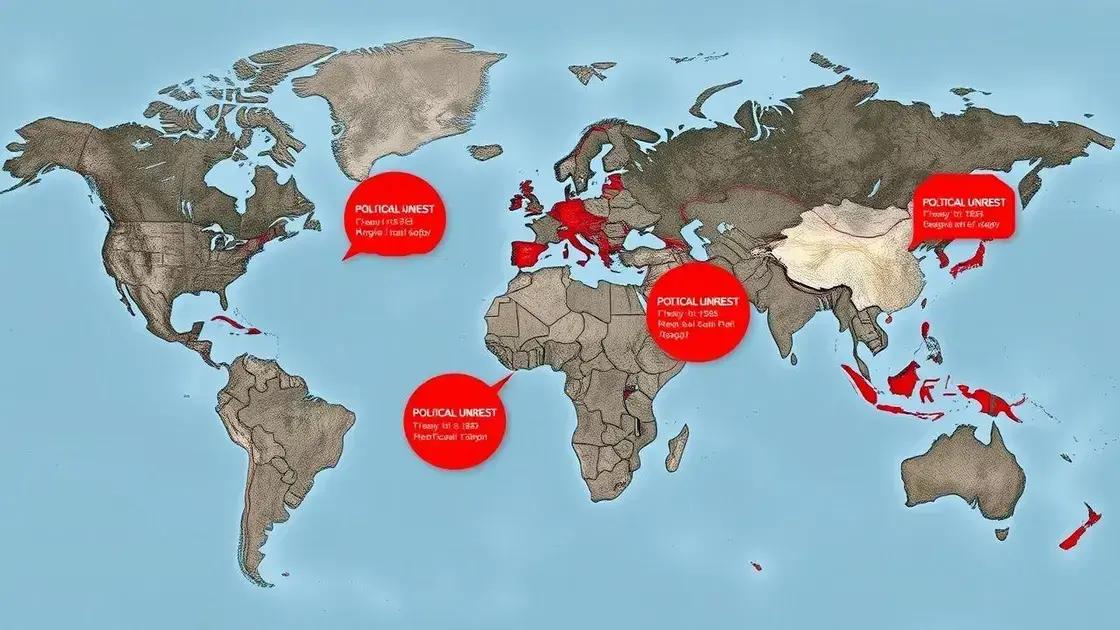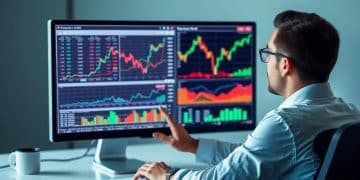Updates on global political instability: what you need to know

Updates on global political instability involve key players, economic impacts, and the effects of social media, all shaping future governance and international relations.
Updates on global political instability can feel overwhelming, can’t they? With so much happening around the world, it’s crucial to stay informed about the events that may shape our future. Let’s dive into the major issues at play.
Current crises shaping global politics
Current crises shaping global politics are crucial to understanding the world today. With events unfolding rapidly, it’s important to grasp how these crises influence international relations and power dynamics.
One significant crisis is the ongoing conflict in Eastern Europe. This geopolitical tension has led to widespread consequences not just for the nations involved, but for global alliances as well.
Middle Eastern Turmoil
Meanwhile, the turmoil in the Middle East continues to pose challenges for regional stability. Nations are dealing with civil unrest and foreign intervention. These issues directly impact global energy markets, leading to fluctuations in oil prices.
- Rising tensions in Iran
- The effects of the Syrian conflict
- Struggles for power in Yemen
In addition, the rise of extremist groups worldwide has elevated fears and concerns over terrorism. Countries are reevaluating their security measures and international cooperation efforts.
Economic Consequences
Economic consequences can also not be overlooked. Instability causes uncertainty in trade and investment, impacting global economies. Countries facing crises often experience inflation and job losses, which may lead to further unrest.
Moreover, climate change adaptation continues to be a growing crisis. Nations must grapple with environmental degradation while addressing socioeconomic factors stemming from it. As demographics change, resource scarcity may also rise.
Understanding these complex interplays is vital. The world is not only reacting to these crises but also seeking long-term solutions that involve diplomatic efforts and humanitarian response.
In today’s environment, being aware of how these crises shape political climates around the globe is essential for both citizens and leaders.
Impact of social media on political movements
The impact of social media on political movements has transformed how information is shared and consumed. Social media platforms have become powerful tools for activists, allowing them to mobilize support and spread awareness quickly.
In recent years, we have seen how hashtags like #BlackLivesMatter have sparked global conversations about racial justice. This illustrates how digital campaigns can amplify voices that might otherwise go unheard. Social media enables individuals to connect across borders, sharing experiences and strategies in real-time.
Mobilization and Awareness
Mobilization is another key aspect of social media’s role in political movements. Organizers can quickly spread the word about protests and events. This immediacy has changed the game for traditional activism.
- Instant updates on protests and rallies
- Building community around shared causes
- Providing resources for activism
Additionally, social media can serve as a platform for alternative news sources. Traditional media often faces constraints, while social networks allow for diverse viewpoints. This can inspire a more informed and engaged public.
Risks and Challenges
However, the landscape is not without risks. Misinformation can spread just as easily as truths. Manipulation of narratives can lead to confusion and division. This highlights the need for critical thinking when engaging with information online.
Moreover, governments may attempt to shut down access to social media during crucial moments. This shows a fear of these platforms’ influence. In some cases, this has led to a push for privacy and anonymous sharing, illustrating the balance between security and freedom of expression.
Through all these elements, the intersection of social media and political movements continues to evolve, shaping the future of activism and civic engagement.
Economic consequences of instability

The economic consequences of instability are profound and far-reaching. Political unrest, wars, and economic downturns can severely impact a country’s economy. One major effect is the disruption of trade. When instability rises, it becomes more difficult and risky for countries to trade products and services.
Trade barriers may increase, leading to higher prices for consumers. Additionally, instability can cause foreign investments to dry up. Investors tend to avoid regions where the risk of losing money is high.
Inflation and Employment
Another critical consequence is inflation. As instability grows, supply chains may break down. This can lead to shortages of essential goods, resulting in rising prices. Many consumers find it harder to afford basic necessities.
- Increased cost of living
- Unemployment rates may soar
- Job security decreases
With high inflation and job losses, families can go through difficult times. In some regions, the social fabric begins to fray due to economic hardship. People may struggle to meet their basic needs, leading to increased frustration and unrest.
Long-term Impacts
The long-term impacts of economic instability can be challenging to recover from. Countries might face reduced growth rates for years, making it difficult to provide services. Health care, education, and infrastructure often suffer as a result.
Moreover, vulnerable populations are often the hardest hit. Women, children, and low-income communities may face greater challenges in navigating through tough economic times. Addressing these issues in the wake of instability is vital for rebuilding society.
By understanding the economic consequences of instability, policymakers can create strategies that both stabilize economies and foster growth in the long run.
Key players in recent political shifts
The key players in recent political shifts have significantly influenced global dynamics. Various leaders, organizations, and movements have come to the forefront, pushing for change and shaping the international scene.
One of the prominent figures is the United States president, whose policies can affect both national and global stability. Decisions made by U.S. leadership often influence other countries and their actions, creating ripple effects around the world.
Grassroots Movements
Alongside political leaders, grassroots movements have gained traction. People are organizing through social media and local initiatives to stand up for their rights. These movements advocate for issues like racial equality, climate change, and democracy.
- The impact of global youth activism
- Role of non-governmental organizations (NGOs)
- Influence of community leaders
International organizations also play vital roles in fostering peace. Groups like the United Nations work to mediate conflicts and provide humanitarian aid. They strive to bring nations together in search of solutions to global challenges.
Emerging Political Figures
Moreover, emerging political figures in different regions are reshaping their countries’ futures. Leaders in Africa and Asia are increasingly vocal on platforms, calling for changes that reflect their populations’ desires. Their influence may shift global alliances and strategies.
With these key players, the landscape of global politics continues to evolve. Each participant contributes uniquely to the dialogue around governance and reform, shaping the course of history.
Future predictions for global governance
The future predictions for global governance are critical as we navigate an increasingly interconnected world. Global governance involves cooperation among nations to address common challenges such as climate change, security, and trade.
In the coming years, we may see a shift towards stronger regional alliances. Countries might band together to tackle issues that impact their specific areas. This could enhance the effectiveness of responses to challenges.
Technological Influence
Another factor shaping the future is technology. The rise of digital communication is likely to change how countries interact. Meetings may become more virtual, allowing for quicker discussions and decisions. This can lead to a more agile approach to governance.
- Increased collaboration through digital platforms
- Real-time data sharing for better decision-making
- Emerging cybersecurity challenges
As technology advances, nations will need to address new forms of conflict. Cybersecurity threats could lead to a rethinking of defense strategies. Countries may collaborate to protect their digital infrastructures and populations.
Focus on Sustainability
Additionally, the focus on sustainability is expected to grow. Governments may prioritize environmental policies, recognizing the need for a united front against climate change. This could lead to binding international agreements to reduce carbon emissions.
Global governance might also involve addressing social inequalities. Leaders will need to work on policies that promote equity and support vulnerable populations. Investing in education and health care can lead to more stable societies.
Overall, the landscape of global governance will likely evolve, reflecting the shifting priorities of nations and their people. Engaging in open dialogues will be essential in navigating these changes effectively.
In conclusion, understanding the updates on global political instability is essential for staying informed about world events. As we navigate the complex landscape of international relations, recognizing the key players and their roles can help us anticipate future developments. The influence of social media, economic consequences, and the shifts in governance will play critical roles in shaping our future. Engaging openly in dialogue and cooperation will be vital in fostering stability and understanding in our global community.
FAQ – Questions about Updates on Global Political Instability
What are the main causes of global political instability?
Main causes include economic crises, social unrest, conflicts, and environmental issues that lead to disagreements among nations.
How does social media affect political movements?
Social media amplifies voices, mobilizes supporters quickly, and allows for real-time sharing of information and protest organization.
What economic impacts arise from political instability?
Political instability can result in trade disruptions, increased inflation, and higher unemployment rates, affecting overall economic health.
Who are the key players in recent political shifts?
Key players include national leaders, grassroots movements, international organizations, and influential activists advocating for change.





